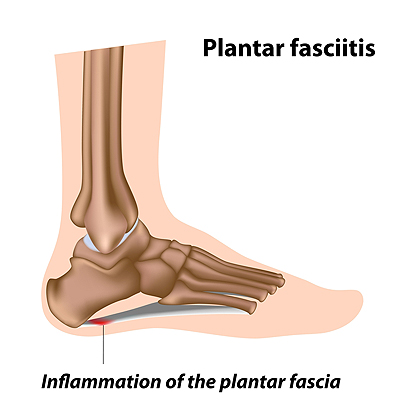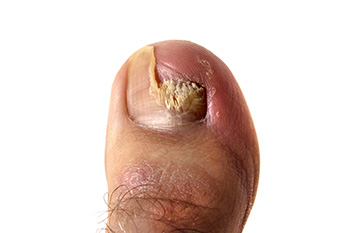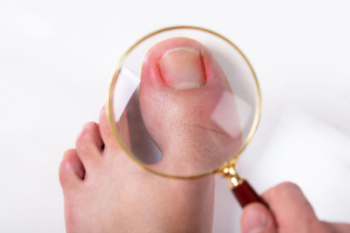Items filtered by date: September 2025
Vascular Disease and Its Impact on the Lower Limbs

When circulation is compromised, the feet, ankles, and legs are often the first to show signs of trouble. Vascular disease restricts the flow of oxygen-rich blood, which can slow healing, weaken tissues, and increase the risk of infection. Even minor cuts, scrapes, or blisters may linger and become chronic wounds because the body is unable to deliver the nutrients needed for repair. Over time, this reduced circulation can also cause skin discoloration, cramping, and a heavy or tired feeling in the legs. People with diabetes or peripheral artery disease face even greater risks, as poor blood flow can lead to ulcers or more serious complications. Protecting the lower limbs means monitoring for changes, avoiding injuries, and seeking care quickly if a wound does not heal. It is suggested that you see a podiatrist for proper diagnosis, management, and treatment.
Vascular testing plays an important part in diagnosing disease like peripheral artery disease. If you have symptoms of peripheral artery disease, or diabetes, consult with One of our podiatrists from Diagnostic Foot Specialists. Our doctors will assess your condition and provide you with quality foot and ankle treatment.
What Is Vascular Testing?
Vascular testing checks for how well blood circulation is in the veins and arteries. This is most often done to determine and treat a patient for peripheral artery disease (PAD), stroke, and aneurysms. Podiatrists utilize vascular testing when a patient has symptoms of PAD or if they believe they might. If a patient has diabetes, a podiatrist may determine a vascular test to be prudent to check for poor blood circulation.
How Is it Conducted?
Most forms of vascular testing are non-invasive. Podiatrists will first conduct a visual inspection for any wounds, discoloration, and any abnormal signs prior to a vascular test.
The most common tests include:
- Ankle-Brachial Index (ABI) examination
- Doppler examination
- Pedal pulses
These tests are safe, painless, and easy to do. Once finished, the podiatrist can then provide a diagnosis and the best course for treatment.
If you have any questions please contact our offices located in Houston, TX, Houston, TX, and Bryan, TX . We offer the newest diagnostic and treatment technologies for all your foot and ankle needs.
Are You Suffering From Nerve Damage?
Stretches That May Help to Relieve Pain From Plantar Fasciitis
 The medical condition that is known as plantar fasciitis can often cause severe pain and discomfort. It affects the heel and arch of the foot, and it may be difficult to walk. The plantar fascia is identified as a portion of tissue that is found on the bottom of the foot, and connects the heel to the toes. Research has indicated there are specific stretches that can be performed which may help to strengthen the plantar fascia. These can consist of sitting on the floor and placing a towel around the bottom of the foot while gently pulling the feet close towards the body. Stretching the calf muscles may help to relieve pain that can originate from plantar fasciitis. This is accomplished by standing on a step, and raising and lowering one heel at a time. If you would like additional information about how stretches may help plantar fasciitis, please consult with a podiatrist.
The medical condition that is known as plantar fasciitis can often cause severe pain and discomfort. It affects the heel and arch of the foot, and it may be difficult to walk. The plantar fascia is identified as a portion of tissue that is found on the bottom of the foot, and connects the heel to the toes. Research has indicated there are specific stretches that can be performed which may help to strengthen the plantar fascia. These can consist of sitting on the floor and placing a towel around the bottom of the foot while gently pulling the feet close towards the body. Stretching the calf muscles may help to relieve pain that can originate from plantar fasciitis. This is accomplished by standing on a step, and raising and lowering one heel at a time. If you would like additional information about how stretches may help plantar fasciitis, please consult with a podiatrist.
Plantar fasciitis can be very painful and inconvenient. If you are experiencing heel pain or symptoms of plantar fasciitis, contact One of our podiatrists from Diagnostic Foot Specialists. Our doctors can provide the care you need to keep you pain-free and on your feet.
What Is Plantar Fasciitis?
Plantar fasciitis is the inflammation of the thick band of tissue that runs along the bottom of your foot, known as the plantar fascia, and causes mild to severe heel pain.
What Causes Plantar Fasciitis?
- Excessive running
- Non-supportive shoes
- Overpronation
- Repeated stretching and tearing of the plantar fascia
How Can It Be Treated?
- Conservative measures – anti-inflammatories, ice packs, stretching exercises, physical therapy, orthotic devices
- Shockwave therapy – sound waves are sent to the affected area to facilitate healing and are usually used for chronic cases of plantar fasciitis
- Surgery – usually only used as a last resort when all else fails. The plantar fascia can be surgically detached from the heel
While very treatable, plantar fasciitis is definitely not something that should be ignored. Especially in severe cases, speaking to your doctor right away is highly recommended to avoid complications and severe heel pain. Your podiatrist can work with you to provide the appropriate treatment options tailored to your condition.
If you have any questions, please feel free to contact our offices located in Houston, TX, Houston, TX, and Bryan, TX . We offer the newest diagnostic and treatment technologies for all your foot care needs.
Understanding Toe Pain From a Stubbed Toe

Toe pain is a common issue that can interfere with walking and daily activities. A stubbed toe occurs when the toe is forcefully hit against a hard surface, leading to bruising, swelling, or even fractures. The pain may be sharp at first and linger as the toe becomes inflamed. While most cases improve with rest, some injuries can be more severe and require medical attention. A podiatrist can determine if the toe is fractured, provide proper treatment, and help prevent long-term complications. If you have ongoing toe pain after stubbing your toe, it is suggested that you schedule an appointment with a podiatrist who can provide effective relief tips.
Toe pain can disrupt your daily activities. If you have any concerns, contact One of our podiatrists of Diagnostic Foot Specialists. Our doctors can provide the care you need to keep you pain-free and on your feet.
What Causes Toe Pain?
Most severe toe pain is caused due to a sports injury, trauma from dropping something heavy on the toe, or bumping into something rigid. Other problems can develop over time for various reasons.
Toe pain can be caused by one or more ailments. The most common include:
- Trauma
- Sports injury
- Wearing shoes that are too tight
- Arthritis
- Gout
- Corns and calluses
- Hammertoe
- Bunions
- Blisters
- Ingrown toenails
- Sprains
- Fractures (broken bones)
- Dislocations
When to See a Podiatrist
- Severe pain
- Persistent pain that lasts more than a week
- Signs of infection
- Continued swelling
- Pain that prevents walking
Diagnosis
In many cases the cause of toe pain is obvious, but in others, a podiatrist may want to use more advanced methods to determine the problem. These can range from simple visual inspections and sensation tests to X-rays and MRI scans. Prior medical history, family medical history, and any recent physical traumatic events will all be taken into consideration for a proper diagnosis.
Treatment
Treatments for toe pain and injuries vary and may include shoe inserts, padding, taping, medicines, injections, and in some cases, surgery. If you believe that you have broken a toe, please see a podiatrist as soon as possible.
If you have any questions please contact our offices located in Houston, TX, Houston, TX, and Bryan, TX . We offer the newest diagnostic and treatment technologies for all your foot and ankle needs.
Understanding Toenail Fungus and Treatment Options

Toenail fungus is a common infection that affects the nails, causing them to become thick, brittle, and discolored. Symptoms may include yellow or white spots, nail crumbling, foul odor, and discomfort while walking. Causes often involve exposure to warm moist environments, such as public showers, gyms, or tight footwear that traps sweat. Risk factors include diabetes, poor circulation, weakened immunity, or repeated trauma to the nails. A podiatrist can diagnose the condition, provide effective treatments, such as topical or oral antifungal medications, or safe nail debridement, and offer advice on prevention. If you have symptoms of toenail fungus, it is suggested that you consult a podiatrist for treatment.
For more information about treatment, contact One of our podiatrists of Diagnostic Foot Specialists. Our doctors can provide the care you need to keep you pain-free and on your feet.
Toenail Fungus Treatment
Toenail fungus is a condition that affects many people and can be especially hard to get rid of. Fortunately, there are several methods to go about treating and avoiding it.
Antifungals & Deterrence
Oral antifungal medicine has been shown to be effective in many cases. It is important to consult with a podiatrist to determine the proper regiment for you, or potentially explore other options.
Applying foot powder on the feet and shoes helps keep the feet free of moisture and sweat.
Sandals or open toed shoes – Wearing these will allow air movement and help keep feet dry. They also expose your feet to light, which fungus cannot tolerate. Socks with moisture wicking material also help as well.
If you have any questions please contact our offices located in Houston, TX, Houston, TX, and Bryan, TX . We offer the newest diagnostic and treatment technologies for all your foot and ankle needs.
Ingrown Toenails Are a Small Problem That Can Become Serious

Ingrown toenails occur when the edge of a toenail grows into the surrounding skin, leading to pain, swelling, redness, and sometimes infection. The area may feel tender to the touch, appear swollen, or drain pus if an infection is present. Walking or wearing shoes can become uncomfortable. Common causes include trimming nails too short, wearing tight shoes, or having naturally curved nails. While mild cases may be managed at home, persistent or worsening symptoms require professional attention. A podiatrist can diagnose an ingrown toenail through a physical exam and determine the most effective treatment. Options include gently lifting the nail, partial nail removal, or treating any underlying infection. In severe or recurring cases, a small portion of the nail root may be removed to prevent regrowth. Prompt care can relieve pain and prevent complications. If you notice signs of an ingrown toenail, it is suggested that you make an appointment with a podiatrist.
Ingrown toenails may initially present themselves as a minor discomfort, but they may progress into an infection in the skin without proper treatment. For more information about ingrown toenails, contact One of our podiatrists of Diagnostic Foot Specialists. Our doctors can provide the care you need to keep you pain-free and on your feet.
Ingrown Toenails
Ingrown toenails are caused when the corner or side of a toenail grows into the soft flesh surrounding it. They often result in redness, swelling, pain, and in some cases, infection. This condition typically affects the big toe and may recur if it is not treated properly.
Causes
- Improper toenail trimming
- Genetics
- Improper shoe fitting
- Injury from pedicures or nail picking
- Abnormal gait
- Poor hygiene
You are more likely to develop an ingrown toenail if you are obese, have diabetes, arthritis, or have any fungal infection in your nails. Additionally, people who have foot or toe deformities are at a higher risk of developing an ingrown toenail.
Symptoms
Some symptoms of ingrown toenails are redness, swelling, and pain. In rare cases, there may be a yellowish drainage coming from the nail.
Treatment
Ignoring an ingrown toenail can have serious complications. Infections of the nail border can progress to a deeper soft-tissue infection, which can then turn into a bone infection. You should always speak with your podiatrist if you suspect you have an ingrown toenail, especially if you have diabetes or poor circulation.
If you have any questions, please feel free to contact our offices located in Houston, TX, Houston, TX, and Bryan, TX . We offer the newest diagnostic and treatment technologies for all your foot care needs.

